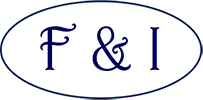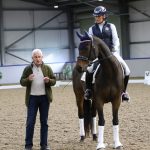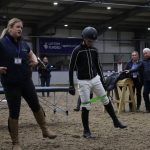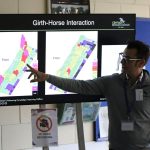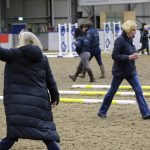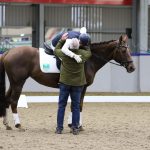Report from the Scottish Equine Coach Assembly
Venue: SNEC, 7-8 October 2024.
Organiser: Jen Morris BHSI, F&I Committee member and our Scottish Representative.
Reports: compiled by the team of Robert Pickles, Liz Eaton, Becky Monk and Alison Craig.
Photographs: courtesy of Sian and JUMAPhotography.
- Ready Steady Coach! In action!
- The Six fantastic lead coaches – L to R Harry Payne, Ferdi Eilberg, Robyn Dunn, Russell McKechnie-Guire, Sam York, John Ledingham
- Ferdi Eilberg explaining
- The Five at the Gala Dinner Q&A: John, Sam, Russell, Robyn, Ferdi
- Robyn Dunn and her pupil and bands
- Russell in action
- John commenting on conformation
- Everyone got involved in the careful walking of distances
- Alice (the rider), Rosie (the mare) and Ferdi, in hug mode
Introduction, and Day 1 (report, Alison Craig BHSI)
Well, that was worth the trip to Edinburgh! Everyone who attended for the stunning 2 day Equine Coach Assembly felt they had real value from their travel and time.
The organisation was impeccable from the start. The BHS lorry was parked outside, and the team dispensed substantial – and sustainably sourced – jute bags, suitably adorned with sponsor logos and stuffed with BHS leather folders, various paperwork, and a very smart (also sustainable!) F&I clipboard, pre-loaded with Jen’s forms and helpful tick-sheets to use as we wished. And we all now have smart F&I pens!
The programme booklet was also impressive – trainer details, horse details, rider details, timetable for each day, descriptions of the intentions for the sessions, QR codes to scan for pre- and post-viewing videos, sponsor adverts…. No mean feat to pull that together! And the “piece de resistance” – some delicious tablet (a very special Scottish fudge, for those not familiar with Scottish traditions) tucked in the corner of the bag. Yum!
We hadn’t yet started and I already had serious admiration for the organising team who put this together. Thanks to the sponsors – F&I Association, BHS Scotland, horsescotland, Agria, SRUC (Rural College), our venue SNEC, and the various professionals who supported it including the technical and IT team and the professional photographer… Jen Morris was in charge of a talented and enthusiastic team.
The location – SNEC (Scottish National Equestrian Centre) – was spot on. I just wanted to clone it and sprinkle versions of it around the world. Two enormous indoor areas, adjacent and linked, incorporating a café, many loos, spacious foyer, various offices, storage…. It was spacious, clean, super surfaces for horse and human, well lit throughout, well cared for, and surrounded by acres of level hard-standing parking…. And 15 minutes from Edinburgh Airport. Well done Scotland!
And did I mention the demo riders Jen sourced, and their wonderful horses? Natives, ponies, cobs, a Clydesdale cross, TB ROR – plus of course the more classically athletic warmblood types…. an intriguing cross-section, with riders ranging from lovely souls who just adored their horses and wanted to have even more fun, to top dressage / eventing / showjumping talent, there to maximise the impact of the coaching available.
Ferdi Eilberg took day 1, dressage. Ferdi of course needed no introduction, with a clarity of coaching philosophy that helped every horse and rider. He started with 3 elementary-level riders in turn – part of the rotation of morning sessions, see below – and progressed up the levels throughout the afternoon. The whole day focussed on the riders’ positions, seat and balance, subtle use of the aids, and the effect they were having on their horses in their search for collection.
Ferdi used circles, transitions, leg-yields and shoulder-in, with attention to detail for the correctness of the body bend – not too much neck bend for true suppleness through the body for the horses. He corrected hand positions, aiming always for the straight line from the rider’s elbow to bit, to be able to connect with the horse in a way that encouraged a forward-thinking soft contact with the bit, and self-carriage. And no dropping off of the engagement and impulsion through the lateral steps. If different strategies were needed on the different reins, so be it – perhaps the stiffer side needs bend then angle, and the so-called supple side needs angle, and only then add bend… read the horse under you and help him/her understand and develop what’s required to become equally supple both ways.
In the afternoon, it was a particular delight watching Ferdi make the most of the Clydesdale’s talent by loosening him over the top line, till he developed a more athletic and rounder frame and made full use of his body. Even more so was the super little TB ROR mare – a session that brought forth my favourite Ferdi saying of the day : ”Don’t stop like you both want to lie down – make a transition!”.
Ferdi had support from the excellent List 1 insights of Harry Payne, judging the tests in the afternoon, and from Robyn Dunn, the eminent Scottish physio, who helped literally straighten out some of the riders in front of us. We also had camera views of the centre line, relayed to big TV screens beside us in the audience. This helped with watching the tests being ridden. You could glance at the screen, check the judge’s mark and comments, & immediately back to the horse & rider, to see their problems and monitor improvements. Brilliant!
That was not all. The jute bags contained a colour-code – so we were split into 3 groups for the mornings, and rotated around sessions with Ferdi Eilberg (day 1) or John Ledingham (day 2), Russell McKechnie-Guire presenting his latest research (day 1 dressage tack, day 2 jumping tack), and Sam York presenting “Ready-Steady-Coach” – a sort of coach-off between two coaches competing to deliver the best exercises with their demo riders. And we were the judges, with red or green apples (on cards) to bestow upon whichever coach whose exercises we preferred in each pair. The coaches in the hot seat ranged from two brave Stage 3 coaches, to the battle of the Winters – Lizzel against Eric – yes, of course Lizzel won in that pairing! Fun and energetic when it worked, possibly more challenging for the lower-level coaches, but lots of learning for everyone and a really great idea. And each morning Sam’s wonderful enthusiasm was ‘knock out’ – an inspiration to us all to put more fun into our coaching!
Russell’s research was of course very popular – dressage-based tack on day 1 and showjumping/ eventing / racing tack for day 2. Insights into saddle pressures, girth pressures, bridle pressures, nosebands (and the pressure-gauge tool being proposed), breastplates (5-point vs racing), slow-motion videos of cornering on grass with studs (none, versus one, versus two), slow-motion of the strains of take-offs and landings…. What a difference can be made removing a cantle (who knew!). So much to think about in terms of the potential for greater comfort for our horses. A one-line take-home message – don’t add more kit, learn to ride properly instead…
The bonus from the clever structure of rotating around the 3 sessions for each morning was that we went from one session into the next – and took the immediate learning from each session with us. We could see many of the things that Russell had briefed us on, occurring in front of us in Ferdi’s session or the Ready-Steady-Coach. Fascinating.
However, possibly the highlight of the whole two days for many of us involved no “tech” whatsoever…. it was Ferdi’s coaching of the TB ROR mare and her charming, rather unconfident rider. When Ferdi‘s attention to the balance of the pair of them produced a joyful mare in a huge free medium trot, he was rewarded with a hug from the lady who said, “I never thought she could move like that!”. Much hugging of the lovely mare, Rosie, who was clearly pleased with herself, and the rider was quite overcome – as were several of us supposedly-hardened BHSIs and Fellows in the audience, tears running down our faces!
We set sail back to the hotel (just 8 minutes away), looking forward to the dinner, suitably inspired and full of what a fabulous day it had been.
And the Gala Dinner on Monday night? A triumph. The Houston House Hotel did all 84 of us proud, with fizz and canapes on arrival, place cards awaiting us with our previously-chosen menus, and the splendid ballroom to ourselves. The bar was open, and a delicious supper was well served by the hotel staff. This was followed by a Q&A panel session with our key presenters, with our organiser Jen Morris as master of ceremonies. Jen elicited a question from each table, posed to Ferdi (the serious one, and of course deeply contemplative answers), Russell (ooh we learned a lot, Russell you won some hearts!), Robyn (insightful, kept it simple), and John Ledingham, who of course gave us some very funny Irish stories as well as his thoughtful and topical replies. Oh and Sam! Sam, you were terrific – again, both thoughtful and funny! Sample question to the Panel: “Why did you choose this career”? A lot of deep thought and honesty from every panellist made this Q&A also quite emotional in its way, with some fascinating answers! Altogether a memorable day and a great evening.
Day 2 – morning – Jumping with John Ledingham (report, Robert Pickles FBHS)
John Ledingham started the session by using the linear scoring system for assessing conformation as this affects what can and cannot be coached. Relating the conformation to training sessions was important in helping to find the horses’ natural balance.
To develop proprioception, flat canter poles were laid out at 22 yds x2 and riders were asked to step out the distances in order to calibrate their length of step. Importance was put on that riders could walk 4 yd canter strides accurately and easily. On several occasions John worked with the physio looking at horses and riders and discussed fitness and suppleness of both. Warm up should be at least 10-15 mins to allow temperature to rise and warm up muscles, and synovial fluid to move to lubricate the joints.
Advice was given to look for neck muscles to ‘pop out ‘ to show that the horses were swinging through the back. John corrected the riders’ light seat positions and was careful to ensure they were bending their horses effectively while the riders rode a figure of 8 with three sets of trot poles to develop good posture through both bends and a relaxed suppleness. After each exercise the riders were asked to be generous in allowing a good stretch holding the buckle-end of the reins to ensure that the horses had freedom to stretch noses down and out.
The canter exercise used the flat canter poles (or planks) at 22 yd x 2, riding 6 strides to 6 strides twice, then 6 strides to 5 strides, then finally 5 strides to 5 strides, on the centre line, with John watching straightness and correcting positions to help riders’ effectiveness in improving balance and posture throughout the exercise. John emphasised that horses should learn not to step on the planks and riders should ride to 1 metre from the plank to allow horses room to place their hind legs easily. Emphasis was put on riders closing the lower leg whilst encouraging lifting of the shoulders, keeping the seat light to help train the horse to collect and maintain a good balance. We were reminded not to squander the opportunity to correct bend and balance and show attention to detail at all times. All the exercises showed how the riders developed an eye for a stride and worked in harmony with their horses.
As the horses were reasonably experienced, an oxer was used in the warm up, to encourage a rounder jump and better technique. This was placed on the E- B line so riders could use turns and changes of direction to improve suppleness and work the horses’ balance and responsiveness.
For the next exercise trot poles to an upright followed by 7 strides to a canter plank were used. This developed the concentration and adjustability of the horse especially to the landing balance. Riders had to be effective, again showing attention to detail.
John stressed care must be taken not to take away the horses’ initiative. Patience was really important, and if the horses made a mistake this showed a lack of balance.
This was a truly inspiring session with so much information and gave everyone so much to reflect on. It certainly took me personally back to training with the late Iris Kellet back in the 80’s.
Day 2 – afternoon – jumping with John Ledingham (report, Liz Eaton FBHS)
The first of the riders in the afternoon session was Wills Oakden on an event horse. The warm-up was discussed and the fact that it takes 15 minutes to get the synovial fluid moving. The other thing that John mentioned was the fact that horses naturally ‘blood dope’ – after the warm-up, whilst they’re waiting to start they withdraw red blood cells and put them back into the spleen – so it’s very important if you’ve been standing around for a bit, you move your horses actively before asking them to do anything with high oxygen demands such as a showjumping course.
John‘s favourite warm-up exercise is a serpentine with three trot poles across each central line. This activates the thoracic sling and lifts the rib-cage, and was very effective. The warm-up is also time for the rider to focus on their responsibilities and principles, in particular their position, their balance and the lines that they are riding. There was a discussion around fitness of the horse and fitness of the rider. Wills likes to ride with short stirrups, and John suggested that he looks behind the movement and to do some exercises on the lunge in the jump saddle without stirrups to develop a balance that is not reliant on the stirrups – which led to a discussion about the need to go the extra mile to get stronger and fitter and pain-free – and to get injuries fixed, as pain inhibits muscle function. It’s detrimental to the horse when the rider is not symmetrical due to old injuries and both rider and horse end up compensating for those.
The next warm-up exercise that John used was three planks on the floor on the central line, 66 feet between each one. He asked the riders to canter to the line six strides between each of the planks then six over the first distance followed by five and then five and five. The object of this exercise is to train proprioception and straightness.
John mentioned that he had been tested using eye-tracking technology. This had highlighted exactly where he looks when he’s coaching and then developed into a discussion about the value of this technology to assist us all in being better coaches and judges.
When it came to riding a course he had all the riders walk the distances and emphasised the importance of measuring your stride and calibrating your stride length so that you are accurate when you walk distances. He was insistent that all distances are accurately measured with a tape otherwise it’s not fair to horse or rider. John discussed the type of fences that he had built; he likes to always warm up over an oxer to encourage the horses to bascule and make a good confident athletic shape to begin with. He also placed the two top poles of the vertical very close together and a big gap down to the ground line to get the horses’ eyes up, encouraging them to back off and jump uphill over the oxer. The ground line position can improve or change the horses’ proprioception of where their take-off point is.
He gave us some coaching tips such as riders don’t hear you when they’re jumping a round – be quiet and then discuss with them afterwards, it checks their recall and awareness of the round. He emphasised the importance of good rider analysis of the course from before fence one to the finish – it trains your rider to be aware of where problems actually start because they are initiated some time before they manifest. And the source is so often the quality of the canter…
The second session was together with Robyn Dunn, Chartered Physiotherapist. Here we were looking at rider asymmetry, in terms of three aspects – tipping forward or back, pelvis slipping to one side causing the upper body to compensate by dropping the opposite shoulder and then rotation in the upper body. We watched the riders go over the same exercise with the poles as Wills did, but this time we were looking at the straightness and symmetry. John had them adjusting the canter from medium to collected using circles to get the horses more elastic through their body to the contact whilst still active. When they started jumping the oxer we were able to observe the riders’ straightness and symmetry as they jumped the fence. There was also the effect of the saddle and the horses’ way of going on the straight. Robyn discussed the importance of activating the glutes – if one is not working as it should it is a major factor in rider asymmetry. Robyn demonstrated how to identify and reactivate glutes, with our demo riders being game to get on the table in front of us all and get straightened out. Robyn emphasised the need to train off the horse. It was interesting to see the immediate improvements made to rider and horse suppleness and straightness when they remounted.
In the third session we had three riders on horses that were jumping 1.30m in competition. John talked about the need to assess the horses using the scale of training and scored each horse on each aspect. We were lucky enough to have a camera filming the horses going down the centre line over the poles which enabled us to evaluate the horses from a different position. At this point John also showed us some Longines-sponsored videos of the ideal canter and approach lines for a variety of fences, including the ideal jump-off lines. This really illustrated the importance of suppleness and balance.
The horse needs to have scope and good reflexes which come from good proprioception. But the rider needs to ensure that the horse arrives at the fence with suppleness and in balance.
John told us that the main difference between national and international competitions is the width of oxers, so in training go wider rather than high, which also encourages the bascule and makes the horse push off the floor more. This prepares the horse for international competitions without the physical stress of adding extra height.
The three horses in this 1.30m group were all quite sharp in the mind, so John emphasised the need for the rider to keep the leg on, riding the horse to the contact to maintain the quality of the canter and enable the horse to produce the jump. A snippet of advice was don’t get stuck on the boards – stay one metre inside, so if you are running deep you can drift out to make space. A common theme was that the riders need to be quick on landing to get their leg on and ride forward to find balance, using their upper body to slow the horse down when necessary.
John likes to build a course for training with three easy fences then a distance to another distance to a difficult turn followed by a distance to another distance and another difficult turn – this really challenges balance and suppleness. John discussed the fact that once you get to 1.30m the level of impulsion needed goes up a notch and shows up whether the horse has got rhythm, suppleness and contact established. If the scales of training are secure the horse will maintain relaxation and jump well, and he will learn and move forward with balance and in rhythm. In conclusion, John‘s principle was that the canter needs to be forward straight and light. And if it’s not good enough, it’s not good enough – fix it.
John was so inspiring to watch, all the horses and riders improved. And he made the sessions interactive, positive and enjoyable for all.
Wednesday 9th October – an additional F&I clinic day with John Ledingham (report by Becky Monk BHSI – one of the CPD places in the arena with John)
This was another great day with John Ledingham, who was very generous with the information he shared. What came through really clearly from the start of the day, and continued on really from the two days of the conference, was his emphasis on the scales of training and their importance through into the jumping. John had a way of scoring conformation which he used when looking at a horse initially and assessing it, and he also had a way of scoring the scales of training, in that initial warm-up and assessment of the horse, before he got too involved in the coaching session.
I would say John had a very systematic approach to his training, and at the core was the scales of training.
Each session’s riders were asked to warm up in a set way using serpentines and trot poles and John felt this was the best way to assess a horse and rider. He said you learn a lot in these first 15 minutes about the training of the horse, and where the horses’ level of training sits and the areas for future development.
He was very clear about his principles and he wasn’t afraid to spend time at the beginning of the sessions on the basics before he started jumping.
He was also keen before anyone started that they dismounted and walked the fences that were set up, but even before they did that he had 3 poles set at 22yards – and he wanted them to walk those poles to calibrate their own stride length before walking the other distances. He made them do this several times over until everyone was happy that they were walking and assessing the distances correctly.
Once they were back on board and ready to jump, John started them with the canter poles, asking them to get 5 strides between each, so developing the rhythm. He said you could tell a lot by the way a horse went down the canter poles, but you already had a good idea from the trot pole work what the canter poles may look like initially.
He then used the 5-stride canter poles at the start of each course he wanted them to jump, to help establish a rhythm and a really good canter. Sometimes he asked them to do the canter poles twice before starting the course.
His first fence was always an oxer as in his opinion there is very little point in jumping an upright that’s less than 1.20m as horses just don’t jump small uprights well. The majority of the fences he used were oxers.
Within the sessions he varied the selection and order of the fences dependent on the individual, as required.
The sessions on the Wednesday started at 1m and moved through the day with groups of 1.10m and 1.20m and then 2 privates of 1.25m and 1.35m. It was a great opportunity to see a wide range of riders and the different levels.
The last session of the day I really enjoyed. The rider came in with a specific brief which John had struggled to get from the other groups. This rider said he had issues with doubles and that the stallion he was riding tended to panic in a double and try to rush through the distance. John was immediately on to seeing what he could do to help – and we all sprung into action to move fences around, making the majority of the fences into combinations. He adjusted the distances for the height of the fences and then watched the stallion jump through 2 combinations. Once he had assessed the technique through the fences he then put a placing pole into some of the combinations, generally 9ft in front of the second element. This helped the stallion to regulate his stride, take his time and therefore encouraged the stallion to have a much more athletic technique over the fences.
John was so quick to assess and form a plan that really impacted on the rider. John had never worked with this rider before, but due to John being so quick to assess and implement a plan the rider really ‘bought into’ the session and was asking John if he would come to Scotland again to near Glasgow to help them with more horses.
A “bonus” end to a memorable Equine Coach Assembly, and a huge thank you to everyone involved in creating and delivering this inspirational conference.
